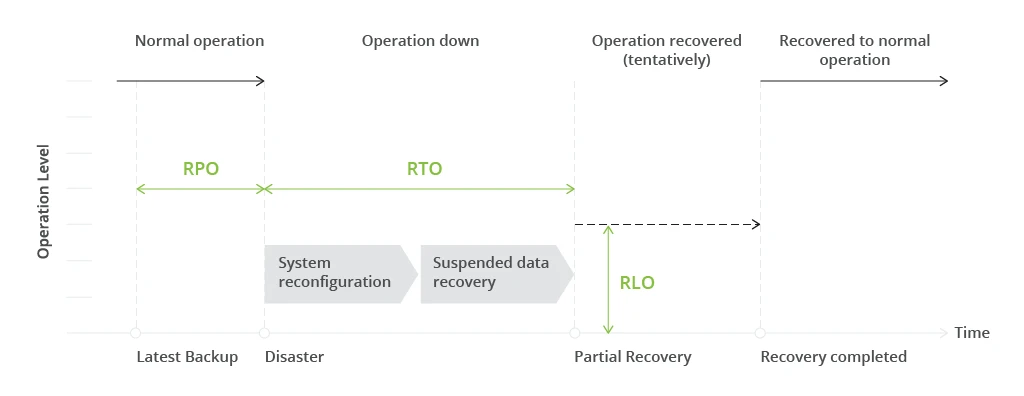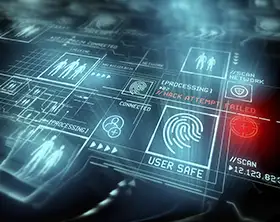Measuring BCDR Effectiveness: Key KPIs for Continuous Improvement
What BCDR Metrics Should Your Company Track?
A BCDR program aims to help your business get prepared for any type of operational disruptions, minimizing downtime and data loss. To understand how well your current plan fulfills this purpose, we recommend tracking the following types of metrics:
- Recovery objectives
- Operational metrics
- Backup Success Rate (the percentage of successful backups versus failed backups)
- Employee Training and Awareness (the percentage of employees trained in BCDR procedures and the frequency of training sessions
- Incident response metrics
- Compliance metrics
- Planning metrics
Recovery Objectives
Recovery objectives indicate the minimal percentage of losses in terms of downtime, productivity, and revenue your organization can sustain. Ideally, downtime of the most critical systems must be close to seconds rather than hours, as one minute of unplanned downtime now costs businesses $14,056.
The three main recovery objectives are:
- Recovery Time Objective (RTO)
- Recovery Point Objective (RPO)
- Recovery Level Objective (RLO)
By defining and tracking these metrics, you can ensure your BCDR solution is optimally configured, and your business maintains sufficient resiliency levels.
Recovery Time Objectives (RTOs)
RTOs reflect the time required to resume operations at a tolerable level after disruptions such as a power outage or a system glitch. High RTO implies extended downtime, which can often cause organizational turmoil and customer dissatisfaction. It also results in financial losses either as lost revenues due to service unavailability and/or service-level agreement (SLA) violations and subsequent customer compensation.
As part of your BCDR strategy, you should measure:
- RTO for critical business workflows and applications
- RTO for restoring core IT infrastructure (cloud services, servers, network, etc.)
- RTO for recovering local data center and alternate site operations
- RTO targets for different disaster scenarios (e.g., a cyber attack or a natural disaster)
Recovery Point Objectives (RPOs)
RPOs codify the maximum tolerable data loss over time following an incident. When the system becomes unavailable, all in-memory data will likely be lost. In some cases, this is mildly frustrating (e.g., when you lose the content of a drafted business email). In others — data loss can create major operational and compliance issues (e.g., if a fraction of customer transactional data is lost).
Having the ability to restore an app within 15 minutes (RTO) and with a data loss of under a minute (RPO) is impressive. However, high RTP/RPO targets require a greater degree of investment both in BCDR software and human resources, increasing maintenance costs.
Therefore, RTO and RPO targets must be set application-by-application, considering the cost and complexity of achieving the proposed target.
Generally, companies track RPO for:
- Business-critical databases and datasets
- Internal sensitive communication and file-shares
- A portfolio of mission-critical business applications
Recovery Level Objectives (RLOs)
RLO is an extra BCDR metric that some teams track to understand how many resources are required to restore a service following a disruption and/or ensure business continuity during a force-majeure event. For example:
- Minimum number of employees required for initial recovery
- Minimum portfolio of applications needed for basic operations
- Minimum number of customer-facing apps to restore first
RLOs help establish the baseline for operation resumption, ensure proper resource allocation, and prioritize efforts in crisis circumstances. When planning a BCDR strategy at Infopulse, one of the first steps we did was to establish RLOs and target actions based on the identified threat levels.
As the Russian-Ukrainian conflict escalated through 2021, we built a BCDR plan relying on threat levels (low, low-to-moderate, moderate-to-high, high, realized threat). It helped us to define metrics based on possible risks and prepare mitigation scenarios. For this, Infopulse established two teams to handle tactical planning and BC operations:
- BCP Operational – a team of 15 people developing and implementing BCDR solutions and emergency response procedures.
- BCP SPOC (Single Point of Contact) – a department that started with 3 specialists and grew to 40 people who coordinated staff evacuation and relocation activities.
The advanced preparations allowed us to maintain continuous service delivery across projects; prevent data loss and service disruption, while also ensuring rapid and safe staff relocation.
Operational Metrics
Every plan is only as effective as its execution. You should ensure that your policies and technologies cover you against all likely threat scenarios. To understand your current standing, you should track the following KPIs as part of BCDR testing and following an incident:
- System Uptime/Downtime ratios measure the proportion of time a system is operational and accessible (uptime) versus the time it is not (downtime). Knowing the percentages helps better prioritize resources.
- Data backup success rate indicates the percentage of successful backup operations. It’s an important metric to understand the effectiveness of your DR solution.
- Disaster recovery exercise pass/fail rate shows the readiness of your workforce to respond to incidents and helps locate weaknesses in your BCDR strategy.
- Cost of downtime quantifies the financial impact of service disruptions. It helps you prioritize the investments in the right areas and estimate your BCDR solution's ROI.
Incident Response Metrics
These metrics primarily concern IT operations and security teams, responsible for executing your BCDR strategy. They help measure how well you can contain risks and resume normal operations. Moreover, they help ensure compliance with regulatory requirements and enhance overall security posture.
Some incident response KPIs you can look at:
- Incident response time indicates the speed of incident detection and response initiation. Fast response times minimize the damage and reduce the recovery costs.
- Mean time to repair (MTTR) shows the average time for resolving an incident. It’s a good measure of the maintenance and efficiency of the restoration processes.
- Number of incidents reported and categorized by severity provides a helicopter view of your resilience levels. A high number and/or frequency of incidents indicates likely underlying problems with your cybersecurity measures or IT infrastructure design.
Compliance Metrics
Many businesses adopt BCDR solutions to maintain compliance with applicable regulations and industry standards. Frameworks like HIPAA, PCI DSS, and ISO 22301, among others, establish requirements for data backups, system security, and tolerable downtime. To see where you stand, it’s worth tracking the number of regulatory requirements met against the total requirements as part of your BCDR implementation plan.
Some businesses also use established BCDR frameworks like NIST or FFIEC as a reference for creating a BCDR plan. Measuring the adherence to the proposed standards also helps assess your program’s maturity levels.
Planning Metrics
This group of metrics provides a high-level view of the effectiveness of your BCDR strategy. Given the size of the IT estates most businesses now have, few companies manage to implement all business continuity best practices in one sprint. Many start with an initial IT infrastructure audit to prioritize the most critical assets and extend protection over them. Likewise, new vulnerabilities and risks emerge over time, requiring updated measures.
To track how your BCDR program performs at present and how it can be further evolved, track the following metrics:
- Business Impact Analysis (BIA) completion rate indicates a percentage of business processes covered by a BCDR solution. While 100% is an almost unattainable goal, you should strive to be at 75% percentile or above.
- Business Continuity Plan (BCP) coverage indicates the percentage of critical processes with a documented BCP policy. It’s a supplementary measure to understand better which areas of business you already have covered and prioritize the next areas for improvement.
- BCP review frequency states the frequency of BCP reviews and updates. Your BCP plan should be reviewed and updated at least annually to account for the new assets, risks, or compliance metrics.
- Number of BCP tests/exercises conducted per year is a good measure to evaluate your teams’ response readiness. Metrics like “time to complete test execution activities versus planned” and “employee participation rates” can provide further data for optimizing your strategy.
How to Enable Continuous Improvement of Your BCDR Program
Conditions change, new technologies (or even companies) get acquired, and your workforce increases. Your BCDR strategy should be attuned to the current risk radar and operational climate at any time. To continuously improve your strategy, establish the following best practices.
Conduct Regular Assessments
Establish a quarterly or an annual review cycle for your BCDR program to ensure your plans remain aligned with the business objectives and technology infrastructure. Ideally, the meeting should be a follow-up after a BCDR audit where you review:
- Actual performance during incidents/tests against predefined targets
- Efficiency of established workflows, monitoring, and reporting processes
- Current BCDR plan coverage rates and next targets
- Gaps in roles, responsibilities, documentation, or technology solutions
The purpose of such an assessment is to reflect on the current progress, identify areas for improvement, and incorporate stakeholder feedback into the updated plan for the next year.
Update Plans and Procedures
Use the tracked metrics and qualitative findings to update your BCDR procedures for the next quarter. If you have acquired new infrastructure, map the new dependencies and establish new DR policies for these based on the assigned importance levels.
Once again, review your IT assets and assess each element of the infrastructure plan. Look for holes and areas that need to be strengthened. As in the case of one of our clients, an in-depth IT audit helps locate flaws and vulnerabilities in legacy systems, subpar configurations of on-premises servers and network hardware, and redundant software licenses (leading to higher costs).
When left unaddressed, all of these factors can become potential incidents affecting your business operations. Complete documentation and well-managed asset inventory help you progressively eliminate weak links and better budget for ongoing initiatives.
Create Feedback Loops
Issues don’t emerge on a fixed schedule. To ensure your BCDR program fulfills its objectives and generates value for your company, create communication channels for offering continuous feedback.
You should solicit feedback both from the teams responsible for BCDR implementation and execution, as well as line of business users. Specifically, seek feedback after:
- Post-incident reviews, following BCDR testing or actual incidents, to understand whether your policies hold up in action.
- Delivering training programs to staff to understand their engagement, satisfaction, and knowledge retention levels from the program.
- Implementing new policies and/or BCDR tools to resolve any adoption resistance and better measure the effectiveness of suggested measures.
Keeping an always-open communication line is essential for securing company-wide buy-in for your program and eliminating the “human factor” from your recovery efforts.
Conclusion
As you can see, a lot goes into measuring BCDR program effectiveness. To avoid chasing the wrong objectives, start with the end in mind: Consider what outcomes you want to achieve. For example, minimize downtime or data loss, ensure compliance with a specific regulation, or effectively scale your program to cover more applications and business processes. Then, select your North Star BCDR metrics to optimize around.
![BCDR measuring effectiveness [MB]](https://www.infopulse.com/uploads/media/banner-1920x528-measuring-bcdr-effectiveness.webp)






![Measuring BCDR Effectiveness [Thumbnail]](/uploads/media/thumbnail-280x222-measuring-bcdr-effectiveness.webp)
![NLP Capabilities and Use Cases [thumbnail]](/uploads/media/thumbnail-280x222-business-process-optimization-with-NLP.webp)
![BCDR for smbs [thumbnail wide]](/uploads/media/thumbnail wide-454x222-business-continuity-and-disaster-recovery-planning-for-smbs-and-enterprises.webp)
![Infopulse BCP im Detail [thumbnail]](/uploads/media/article-infopulse-bcp-implementation-280x222.webp)





